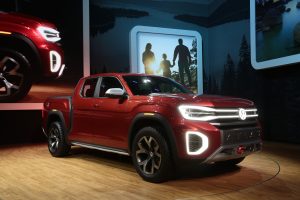
Shoe Leather in Search of New Cars
March 28 was Media Day at the New York International Auto Show (the first of two Media Days, to be precise) and the team from CarShowSafari wore ourselves out covering the entire show floor all day and visiting the manufacturers’ parties all evening. What did we learn?
Aside from learning that our ability to stay on our feet for endless hours ain’t what it used to be, we learned to adjust our perception of “new.” For decades – over a century, really – the New York show and other major auto shows have been where the manufacturers unveiled new car models and showed off splashy concept cars. In New York there were fancy presentations of new or updated models by Toyota (RAV4), Lincoln (Aviator), Cadillac (XT4), Nissan (Altima), Jaguar ( F-Pace SVR), Acura (RDX and MDX A-Spec), Audi (RS 5 Sportback), Kia (K900), Volkswagen (Atlas Cross Sport), Subaru (Forester), Lexus (UX), Honda (Insight), Volvo (V60 Wagon and XC40 Inscription), and others. So the whole notion of “new” as part of the show’s appeal remains.
But what is new about these cars is not their appearance. Annual model-year changeovers have long since given way to new-car style marked by glacial change. The newness has to be found elsewhere. And in a number of instances what was passing for new this year was not “new” but “where.” The Kia Stinger was a big deal not because it was groundbreaking in engineering or design, but because it comes from South Korea and was shepherded to production by a design chief poached from Germany. Similarly, the Genesis Essentia, an honestly show-stopping concept car in the mold of the “futuristic” cars from the auto shows of our fathers, was generating comments as much for its country of origin as for its idealistic engineering targets.
What is new today is tech: A truly remarkable percentage of what we saw in New York may have looked like what we have seen before, but were either production-ready or pre-production gas-electric hybrids or full electrics. Virtually every one of the new cars touted its touch-screen interface. Audi, as we noted in our pre-show piece, was showcasing speech recognition as were others. Smartphone compatibility is a given.
 In fact, the only new car unveiled in New York that seemed new in the old sense of the word was the Volkswagen Tanoak pickup, a vehicle presented as a concept but which looks very close to production-ready. While it includes much of the tech features seen elsewhere, it is really just a new and unexpected vehicle. It was drawing some of the greatest general interest following its unveiling, some of which is understandable because it was not announced beforehand, but much of which was because it was, simply, new.
In fact, the only new car unveiled in New York that seemed new in the old sense of the word was the Volkswagen Tanoak pickup, a vehicle presented as a concept but which looks very close to production-ready. While it includes much of the tech features seen elsewhere, it is really just a new and unexpected vehicle. It was drawing some of the greatest general interest following its unveiling, some of which is understandable because it was not announced beforehand, but much of which was because it was, simply, new.
Another adjustment that we needed to make in New York was to alter our definition of “automobile.” It is no secret that trucks and SUVs are claiming an ever-growing portion of the overall market for new cars, to the detriment of conventional sedans. But so pervasive is this change that in New York, Subaru had no cars in their display. Just SUVs (or crossovers, if you prefer). No Impreza, no Legacy, no BRZ, not even an Outback. A Subaru spokesperson did say that an Outback would be moved into the show following the Media Days, but clearly, the focus is on the truckettes.
Cadillac? New crossover. Buick? New crossover. Volvo? New SUV. Crossovers and SUVs virtually everywhere. Well, except one place. Chrysler’s display, not as badly hidden as last year but still cause for concern about the brand’s longevity, was a passel of Pacifica minivans and one lone 300 sedan. These are the only two Chrysler-branded vehicles offered today, and while it emphasizes the shift of the industry away from sedans, the lack of even a single SUV or crossover does not bode well for Walter P’s namesake brand.
 And finally, as we watched the crowd at the VW stand, checking out the Tanoak pickup (where does Volkswagen get their names?) and the Atlas Cross Sport, we noticed that part of the display was a poster of a classic VW Bus from the 1960s. Okay, we get it, everybody loves the classic V-Dubs, us included. But Volkswagen, with the last of the air-cooled Beetles and Buses having been offered here in the US during the Carter administration, it is time to stop trying to trade on nostalgia and make cars that people love today.
And finally, as we watched the crowd at the VW stand, checking out the Tanoak pickup (where does Volkswagen get their names?) and the Atlas Cross Sport, we noticed that part of the display was a poster of a classic VW Bus from the 1960s. Okay, we get it, everybody loves the classic V-Dubs, us included. But Volkswagen, with the last of the air-cooled Beetles and Buses having been offered here in the US during the Carter administration, it is time to stop trying to trade on nostalgia and make cars that people love today.
You had quite a loyal following of diesel fans, but you screwed that up about as well as it could be screwed up. For a time, the Passat and Jetta were well-regarded – even Consumers Reports gave the Passat high marks – but you lost your way with those models. Better find a new groove soon, Volks… or start making Hippie vans again. ![]()

